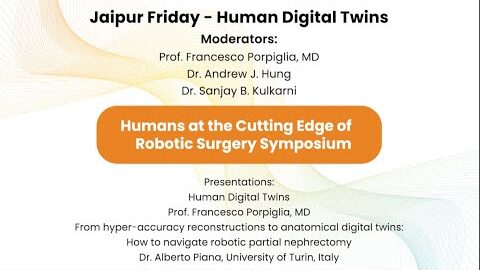Robot assisted partial nephrectomy in challenging clinical scenarios: Our experience
This video, produced by Vattikuti Fellow Dr. Saurabh Patil, took First Place in the KS National Robotic Surgery Video Awards at the December 2018 Robotic Surgeons Council of India Meeting. Here is the Abstract:
Robot assisted partial nephrectomy in challenging clinical scenarios: Our experience
Saurabh Patil, Ashwin Tamhankar, Surya Prakash Ojha, Puneet Ahluwalia, Gagan Gautam.
Dept of Uro-Oncology, Max Institute of Cancer Care, Max Super Speciality Hospital, Saket, New Delhi.
Introduction:
Robot assisted partial nephrectomy (RAPN) is now gaining the popularity as a minimal invasive approach to manage small renal masses (SRMs). However, surgeons may face technical difficulties in certain situations, like hilar tumors, completely endophytic tumors, complex renal anatomy, post renal surgery or percutaneous renal procedure.
We share our experience and describe our techniques in dealing with such scenarios in 3 representative videos.
Methods:
Our 1st case is a 55-year-old diabetic hypertensive female with a large upper polar mass extending upto renal sinus (RENAL score 9x), with a history of percutaneous radio frequency ablation. Intraoperatively we had difficulty in upper pole mobilisation due to dense perirenal adhesions and in localization of tumor resection margins due to its endophytic nature.
Our 2nd case is a 67-year-old diabetic female with a hilar mass in close relation with renal vessels and inferior vena cava (RENAL score 8ah).
3rd case is a 43-year-old diabetic hypertensive gentleman with a complete endophytic mass in interpolar region (RENAL score 10a).
In all 3 patients we could successfully perform robot assisted partial nephrectomy without any intraoperative complication.
Results:
Total console time was 263, 177 and 161 minutes and warm ischemia time 50, 35 and 32minutes in 1st, 2nd, and 3rd case respectively. All 3 patients recovered well after surgery. Total length of hospital stay was 2 days with no complications in postoperative period.
All three patients have good oncological as well as renal functional outcomes at 1st follow-up.
Conclusions:
Robotic approach can be used safely and effectively even in complex and difficult cases and so should be offered wherever feasible.
Dr.Saurabh Patil,
Vattikuti Fellow, Robotic Uro-Oncology,
Max Superspeciality hospital,Saket, New Delhi.
Robotic surgery video, with PPT’d, CT Scans, Port placement photos, Ultrasound images (during robotic surgery) Narrated, 07:57
Date
August 15, 2020






